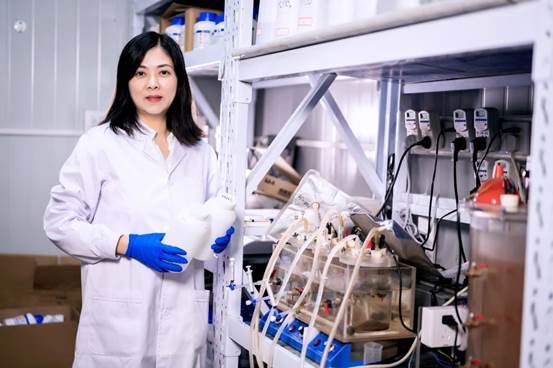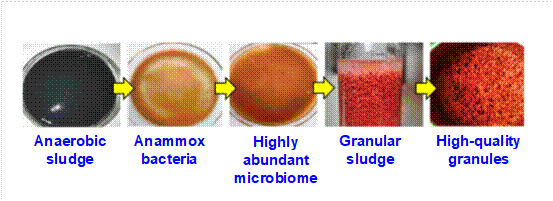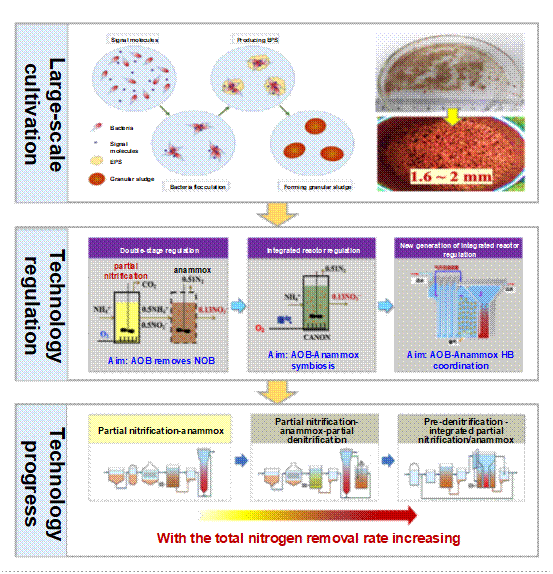Recently, Professor WANG Yayi's team from the College of Environmental Science and Engineering won a first prize of the Shanghai Science and Technology Award 2020 for their project titled Key Technology Innovation and Application of Anammox Process in High Ammonia-nitrogen Wastewater. "We have forged a 'special force' that has its origin in wastewater and purifies itself, which was eventually applied in wastewater purification. We solved the problem of denitrogenation of high ammonium-nitrogen wastewater successfully." WANG Yayi told the correspondent.

WANG Yayi at work
The nitrogen content of high ammonia-nitrogen wastewater in China amounts to 4 million tons a year, accounting for more than 70% of the nitrogen content of industrial wastewater. The various types of high ammonia-nitrogen wastewater and the complicated water quality are at issue. Therefore, reinforcing the denitrogenation of high ammonium-nitrogen wastewater is a critical mission to win the “battle for clean water". High ammonia-nitrogen wastewater, however, has high ammonia-nitrogen concentration, complex components, great environmental hazards, and treatment difficulties. The traditional denitrogenation technology has a long process, large chemical dosage, high energy consumption, challenging operation and maintenance, and severe secondary pollution hazards. To resolve this worldwide problem of the denitrogenation of high ammonia-nitrogen wastewater in the field of wastewater treatment, there is an urgent need to develop new low-consumption and high-efficiency denitrogenation technologies.
Dutch engineer Gijs Kuenen discovered in 1999 that anammox bacteria belonging to the Planctomycetes can convert ammonia-nitrogen into nitrogen without a carbon source. Since then, the exploration and utilization of anammox bacteria that can "oxidize" ammonia-nitrogen in an anaerobic environment have gradually become a topical issue. "However, due to the difficulty of anammox bacteria enrichment, slow reactor start-up, coupled with technical bottlenecks such as unstable operation, the road to engineering application of anammox technology in the field of high ammonia-nitrogen wastewater is very challenging" introduced by WANG Yayi.
WANG Yayi said that environmental friendliness should be put first in wastewater treatment in this low-carbon era, so it is significant to find suitable weapons. Utilizing the characteristics of a high concentration of ammonia-nitrogen in wastewater, we managed to build a "special force" to remove nitrogen in the wastewater in a low-carbon way. Therefore, it can continue to thrive while defeating the "enemy". After reiterative arguments and selections, our team found that the efficient breeding of anammox bacteria was theoretically feasible. Then, we started to overcome difficulties for more than ten years, and concentrated on producing fruitful results in wastewater treatment.
"Professor WANG, I feel that your technology is quite interesting: it's like trying to train a special force in the sludge to fight against a stubborn army (high concentration of ammonia-nitrogen in wastewater). According to your technical route, these special forces were carefully forged and finally became the Marine Corps." The correspondent told WANG Yayi of his interpretatoin of her research results.
"Your interpretation is correct. We did believe it that way." WANG Yayi said. In the past ten years, our team has overcome numerous difficulties and finally formed an anammox technology system with completely independent intellectual property rights. It pioneered the large-scale cultivation of anammox bacteria and the optimization and coordinated regulation technology of nitrogen removal functional bacteria, and carried out the deep denitrogenation engineering application of high ammonia-nitrogen wastewater with the anammox granular sludge reactor as the core. It successfully solved for the first time the international challenges of thermal hydrolysis anaerobic digester effluent and leachate treatment.

Figure 1. Large-scale cultivation technology based on the oriented cultivation of anammox bacteria theory
According to WANG Yayi, the team invented rapid oriented breeding and high abundance enrichment technology for anammox bacteria, and realized the large-scale cultivation of bacteria. This technology realized oriented and efficient breeding of anammox bacteria and the high abundance enrichment of dynamic membranes, shortening the domestication period by 4 times. It also pioneered the rapid formation and enhancement technology of anammox granules, the degree of granulation exceeds 95%, and the strength is increased over 2 times, which realized the rapid and large-scale cultivation of anammox bacteria.
Invented a multi-microbiome optimization and coordinated regulation technology of nitrogen removal functional bacteria, which overcomes the problem of rapid start-up and stable operation of anammox. The team’s invented the partial nitrification regulation technology, in which AOB (ammonia-oxidizing bacteria) removes NOB (nitrite-oxidizing bacteria), so that the accumulation rate of nitrite is higher than 90%. It also invented the predominant bacteria symbiosis technology under the control of dissolved oxygen, and conducted independent research on the development of a new generation of integrated anammox granular sludge reactor, which greatly improves the total nitrogen removal efficiency.
Moreover, the team constructed a deep denitrogenation system with anammox as the core and applied it in engineering. The team also built an efficient and deep denitrogenation system with anammox granular sludge reactor as the core, and successfully applied it to the denitrogenation treatment of thermal hydrolysis anaerobic digester effluent and leachate, with a total nitrogen removal rate higher than 93%, which reduced the operating cost of 40%~50% compared with the traditional method, and greatly improved the treatment level of high ammonia-nitrogen wastewater in China.

Figure 2. innovative results in theoretical innovation, technological invention, equipment development, and engineering application of the team after more than ten years of technology breakthrough in industry-university-research cooperation
The achievements of this ecological project have been successfully applied to high ammonia-nitrogen wastewater treatment projects such as the anaerobic digester effluent, leachate, and coal chemical industry in Suzhou, Changsha, Qinhuangdao, Lianhetech (Dezhou Site), Lianhetech (Yancheng Site), Anhui Haoyuan Chemical Group, Shaanxi Jingyi Chemical and other places. It has reached a total application scale of 6,300 tons per day, reducing nitrogen emissions by 2,447 tons per year, saving 100% of carbon sources and 50% of power consumption. In the past three years, the direct economic benefits have added 230.55 million yuan in output value, 51.683 million yuan in new profits, and 7.75 million yuan in new taxes.
Correspondingly, the team has applied for 31 patents, among them 23 authorized invention patents. It also published 135 papers, including 81 high-level papers (cited 2441 times by other scholars), and 2 monographs. "The project achievements have significantly improved the technical level of China's high ammonia-nitrogen wastewater treatment, promoted technological progress in wastewater treatment and resource utilization, and reached the international advanced level as a whole" commented by specialists in the industry. (CHENG Guozheng)
https://news.tongji.edu.cn/info/1003/78133.htm